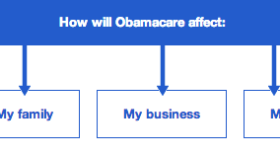Second Opinion is a weekly Q-and-A series that answers questions from San Diegans on the Affordable Care Act. Ask yours here.
The Question: Is it cheaper for a company of 50 or more employees to pay the penalty for not offering health coverage than to sponsor a health plan?
Rich Martindell started flying planes when he was 15. Now he works in San Diego's aviation industry, teaching others how to fly and investigating crashes. (You may have seen him offering his expert analysis to local news outlets earlier this month when an Asiana aircraft crash-landed in San Francisco.)
Martindell said, like most local industries, the companies that keep planes taking off from Montgomery Field in Serra Mesa — plane maintenance shops and fuel businesses — are trying to figure out what the Affordable Care Act means for them.
"They're not Boeing," Martindell said, but they're big enough to fall under Obamacare's employer mandate, which says companies with 50 or more full-time employees must offer adequate health coverage or pay a fine.
Here's Martindell's question:
Will small companies with, say, between 50 and 100 employees find it cheaper not to carry coverage and pay the fine?
The Takeaway: At face value, the fine is cheaper.
First, let's get this out of the way: Do you know how many full-time employees you actually have?
The threshold for Obamacare's employer mandate cannot be calculated with a simple headcount; it's calculated by hours. The federal government counts each 30 hours worked, even if two part-time employees share it, as a full-time position.
In other words: Divide the total number of hours all your employees put in each week by 30. If the result is 50 or more, you need to cover your full-time employees. Your part-timers factor into whether the mandate applies, but you do not have to insure them.
Now for the cost comparison.
For that, we'll use the average premium for an employer-sponsored HMO plan in San Diego right now — about $5,000 per individual — and the annual fine for failing to offer adequate coverage — $2,000 per employee (but the government waives the fine for the first 30).
The answer seems easy: $2,000 is a lot less than $5,000. But, according to Linda Keller, the executive vice president of San Diego-based insurance brokerage Intercare, there are some things to consider:
- Companies aren't paying the full $5,000 premium. Typically, employees pay around 20 percent, decreasing the employer contribution to $4,000.
- But technically, an employer only needs to pay enough to ensure their employees aren't pitching in more than 9.5 percent of their household incomes. If your employees make more than $32,000, you could pay less than $2,000 each and still comply with the law. But Keller said she's never seen an insurance carrier OK an employer contribution of less than 50 percent, or $2,500.
- Employers can deduct what they pay in insurance premiums on their taxes. According to Keller, the standard deduction is 35 percent, potentially bringing the cost of coverage down to $1,625 per person.
- But even if your real-world plan doesn't pencil out to be less than the penalty, Keller had this to add: Not providing benefits can affect recruitment and retention. If you strip down or ax your benefits package altogether, you'd have to raise your salaries to remain competitive. And you're not just increasing pay at that point; you're also increasing payroll taxes, life insurance, disability insurance, etc.
One last thing to consider, under Obamacare, businesses must also cover the premiums for their employees' children up to age 26.
The Orders: Forget the mandate delay. Figure this out now.
The Obama Administration recently extended the deadline for businesses to offer coverage from 2014 to 2015. But you might want to pull out your calculator and time sheets now.
The Internal Revenue Service's current interpretation of the law asks businesses to keep track of their employees' hours over six months next year to determine who must be covered. They'd then enroll those employees in the latter half of 2014, with coverage beginning in 2015. The process could change, however, as the White House works out the kinks.
Check out last week's Second Opinion: Do I have to cover my three employees?








